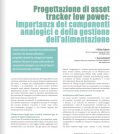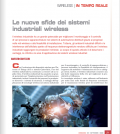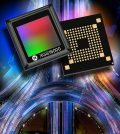Wireless – Answers provided by AJ ElJallad, sr. manager, communications segment ON Semiconductor

EONEWS: What are your opinions regarding the major trends for this market (slowing, growing, booming…)?
ELJALLAD: The wireless phone market is growing rapidly. Within the rapidly growing wirelessmarket, smart phones are growing at a high rate while feature phones are forecasted to decline quarter on quarter. Q2 2013 saw the first higher shipments of smartphones than feature phones and this will be a continuing trend moving forward. With the popularity of smart phones, a segmentation of high-tier, mid-tier, and low-tier is becoming more visible. We see the high-tier category of smart phones reaching a saturation point in the market while the mid- and low- tiers are gaining more market share and will be the dominating tiers by the end of 2014.
EONEWS: What are the key strategies adopted by your company in the short/medium period to address (or to better address) the needs of the market?
ELJALLAD: ON Semiconductor’s strategy is to provide a differentiated solution to the smart phone market. This includes the expansion of IP and capabilities within our current competencies as well as investing in new technologies that provide an additional value to our customers. We are also focused on aligning our efforts and design activities with the top OEMs in this market as well as partnering and providing solutions for the major chip-set providers for smart phones.
EONEWS: What are you doing in order to implement your strategies (partnership/agreements, new acquisitions, investments in activities like R&D, people….)?
ELJALLAD: In order for ON Semiconductor to accomplish these strategies, we have invested in dedicated support and design teams for the wireless market as well as setting up Solution Engineering Centers (SECs) located in key locations worldwide to offer additional design capabilities to our customers. As stated before, we are also investing in new IP that offers our customers additional value and flexibility in their designs.
EONEWS: What are the most important application?
ELJALLAD: For ON Semiconductor the key areas are mainly in antenna RF tuning ICs, Optical Image Stabilizer (OIS) and Auto-Focus (AF) for camera modules, ESD protection and EMI filtering. We also offer a broad offering of analog and power management solutions.
EONEWS: Which are the key factors that set your company apart from the competition?
ELJALLAD: ON Semiconductor is unique in that we have broad range of offerings for multiple markets. We have devices that are smaller than a speck of pepper, all the way to high end ASICs with hundreds of pins; from a simple diode or transistor to a high end DSP. This broad product offering allows us to reuse our capabilities and expertise across various markets to develop very competitive solutions. ON Semiconductor also boasts a best-in-class supply chain and customer support team with high volume support capabilities that meet the demanding mobile phone market. The company shipped more than 40 billion units in 2012 and is on track to exceed this in 2013.
EONEWS: And in the middle/long term (if you have a crystal ball!)?
ELJALLAD: My crystal ball tells me that the focus will continue to be on high-tier smart phones with their higher priced bill of materials as well as mid-tier smart phones with their higher volumes and mid priced bill of materials. I also see the chip-set arena becoming more competitive with the entry of Intel into the smart phone market and MediaTek’s introduction of higher end chip-sets for smart phones and tablets. In addition, I think we’ll see LTE coverage continue to expand worldwide and in parallel OEMs will introduce more phones with LTE-advance capabilities. Finally, in the future, your phone will be charged while it is still in your pocket – no need to worry about cables or wall plugs.
Edited by the Editorial Staff
Contenuti correlati
-
Sostenibilità: il ruolo della tecnologia elettronica
Grazie alle soluzioni sostenibili è possibile ridurre sprechi, consumo di energia e oneri di manutenzione Leggi l’articolo completo su EO 521
-
Mouser mette a disposizione una piattaforma di contenuti sul wireless networking
Mouser Electronics ha implementato una piattaforma di contenuti sulle reti wireless per fornire agli ingegneri le risorse più recenti per gli standard di networking. Protocolli come Wi-Fi 6, Wi-Fi 7 e Matter stanno infatti mettendo alla prova...
-
Le sfide del wireless per le strutture ospedaliere
Un’analisi di vantaggi e limiti della tecnologia Wi-Fi nell’ambito delle apparecchiature medicali utilizzate negli ospedali e nelle cliniche Leggi l’articolo completo su EO Medical 25
-
Le previsioni di Cambium Networks per le tecnologie wireless nel 2023
Atul Bhatnagar, CEO di Cambium Networks, ha esaminato i trend più significativi del 2023 per quanto riguarda la connettività wireless. Grazie agli investimenti, ai finanziamenti pubblici e all’interesse generale per la costruzione dell’infrastruttura a banda larga, il...
-
Progettazione di asset tracker low power: importanza dei componenti analogici e della gestione dell’alimentazione
Questo articolo esaminerà le problematiche tecniche che devono affrontare i progettisti durante lo sviluppo dei tracker wireless: l’accento è posto sulla scelta dei componenti analogici e sui vincoli imposti dal funzionamento a batteria Leggi l’articolo completo su...
-
Le nuove sfide dei sistemi industriali wireless
Il wireless industriale ha un grande potenziale per migliorare il monitoraggio e il controllo di vari processi e apparecchiature nei sistemi di automazione distribuiti grazie ai progressi nelle reti wireless e alla flessibilità di installazione. Tuttavia, gli...
-
I parametri chiave per la scelta della tecnologia wireless più adatta: coesistenza, consumo di potenza e sicurezza (Seconda parte)
Nella prima parte di questa serie sono stati analizzati numerosi elementi utili per scegliere la tecnologia wireless più adatta per un particolare progetto tra cui lo spettro di frequenza, lo spettro coperto o meno da licenze e...
-
I parametri chiave per la scelta della tecnologia wireless più adatta: spettro di frequenza, distanza di comunicazione e topologia di rete (prima parte)
Il gran numero di standard e protocolli wireless esistenti può rendere difficoltosa la scelta della tecnologia più idonea da utilizzare per una specifica applicazione. In questo articolo verranno esaminati i principali criteri da prendere in considerazione e...
-
Apre a Carugate il laboratorio italiano di UL per la compatibilità elettromagnetica e wireless
UL ha ufficialmente aperto un rinnovato e ampliato laboratorio per la Compatibilità Elettromagnetica (EMC) e wireless a Carugate, a 20 chilometri da Milano. Il laboratorio fornirà un’offerta completa e personalizzabile di servizi per testare la compatibilità elettromagnetica...
-
Un nuovo sensore XGS da 16 Mp da ON Semiconductor
ON Semiconductor ha aggiunto alla sua serie di sensori di immagine CMOS XGS, il modello 16000. Si tratta di un sensore da 16 Megapixel che fornisce immagini di alta qualità per applicazioni di automazione industriale, tra cui...
















